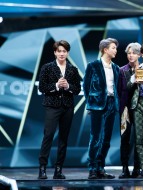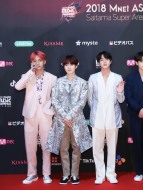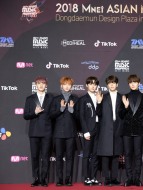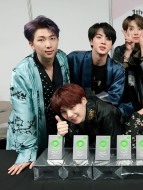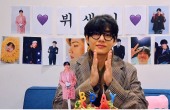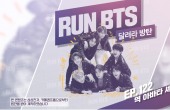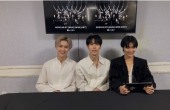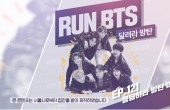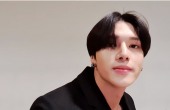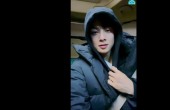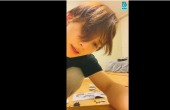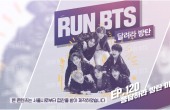Wellspring of creativity and drive
By Kim Hoo-ran
Be careful what you say, his mother had warned him as a young boy. “What I said had a funny way of coming true,” said Jung Ku-ho recently in an interview with The Korea Herald at a cafe in Itaewon, Seoul.
Divine intervention probably has little to do with Jung’s trailblazing success as a fashion designer and, now, creative director. Rather, creativity, drive and being at the right place and at the right time probably explain Jung’s ability to realize his dreams, as far-fetched as those dreams may have seemed -- initially, at least.
As a youngster, Jung’s heart was in music. When his father opposed the idea of his son becoming a musician, the son turned to fine art. When he once again faced parental disapproval, he turned to studying communication design and eventually fashion design.
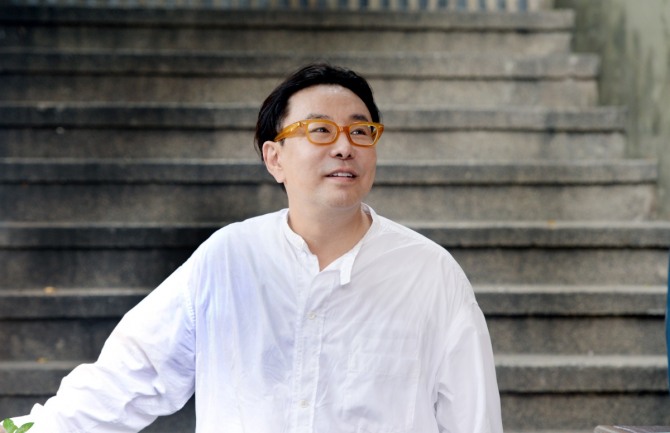 |
| Creative director Jung Ku-ho poses at a cafe in Itaewon, Seoul on July 21. (Park Hyun-koo/The Korea Herald) |
Jung has now come full circle as the creative director of Korea National Opera’s “La Traviata,” which will be staged from Aug. 26-27 at the Olympic Park in southern Seoul. Jung admits that he has a habit of getting things his way.
“After my last work with the National Dance Company of Korea, I kept telling everyone I met that I really wanted to do opera,” Jung said. He was the art director for “Banquet” (2015), which won critical acclaim for combining contemporary aesthetics and traditional dance.
Finding modernity in tradition
Most people know Jung as an iconic fashion designer. Upon returning from New York, Jung opened a small boutique, KUHO, in 1997. With Jung’s touch of avant-garde and minimalism, KUHO was a breath of fresh air in the Korean fashion scene and became one of the first to make a successful transition from a boutique to a nationwide brand. In 2003, then-Cheil Industries -- the company has since changed its name to Samsung C&T -- acquired KUHO, and Jung remained with Cheil Industries for some 10 years before leaving the company and his namesake brand behind him in 2013.
Does he have any qualms about having “lost” his name? The answer is a quick and adamant “no.” “I started thinking about leaving after about five years. Ten years and seven months with a company is a long time for a designer,” he said.
He had said at the time of his departure from Cheil Industries that he wanted to venture into other artistic endeavors. He had been involved with several films as art director or costume designer even during his years at Cheil Industries. They include the visually scintillating 2003 film “Untold Scandal,” director E J-yong’s adaptation of the 18th-century French novel “Les Liaisons Dangereuses (Dangerous Liaisons),” set in the late 18th century Joseon era. The film was a pivotal moment for hanbok: Since then traditional Korean clothing has become a “lead character” in period films and dramas, according to Lee Hae-soon, the hanbok designer who created costumes for “Untold Scandal.”
Jung has brought his unique sense of aesthetics to the stage productions in which he has been involved -- as costume designer, stage designer as well as director in some instances.
In 2012, he worked with the Korean National Ballet in “Poise,” which was stark in its modernity. The following year, he directed the National Dance Company of Korea’s “Altar,” with choreography by Ahn Sang-soo, who now heads the Korea National Contemporary Dance Company, as well as NDCK’s “The Scent of Korea,” another lavish feast for the senses. In 2015, he served as the art director for NDCK’s “Banquet,” a piece which he had conceived and suggested to the dance company.
It is curious that a fashion designer known for modernity should choose to work with traditional Korean dance. But the results have been stunningly refreshing, as Jung strips away the old, stuffy layers to reveal thoroughly modern aspects of tradition.
‘La Traviata’ with Korean ethos
A couple of weeks ago, after casually glancing at the Korea National Opera’s press release headlined “Lady of the Camellias” in Korean, for a fleeting few seconds I thought the opera company was staging an original opera in Korean. I then noticed the name Jung Ku-ho on the release as well as that of Kim Young-in, a hanbok designer known for her iconoclastic take on tradition characterized by the use of prints. This is going to be a very unique production, I thought, followed quickly by “Will this work?”
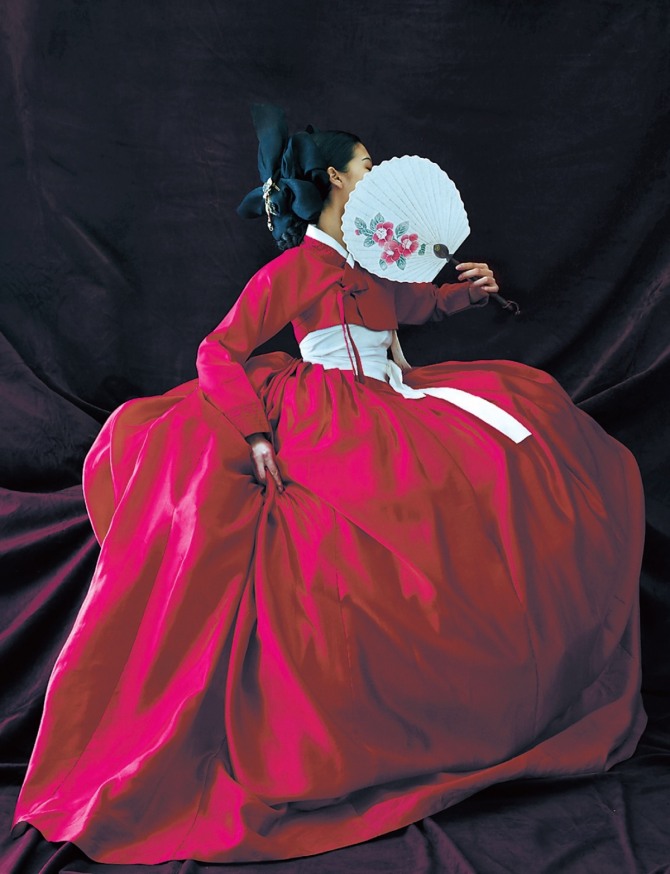 |
| An image for “La Traviata” (Korea National Opera) |
Jung admits it is a big challenge: An outdoor stage with all the difficulties that entails, the first-ever attempt to dress the singers in Korean traditional costumes, which will largely influence the singers’ movements and expressions, not to mention the sudden resignation of the opera company head. “I am really paying my dues as a first-timer,” Jung said.
To make matters worse, New York-based soprano Hong Hae-kyung, who was originally cast for the lead role of Violetta, quit due to health reasons. In fact, I received a press release announcing her replacement with Hamburg State Opera’s Lee Ha-young on my phone during the interview with Jung.
‘Wholly my own ideas’
With many friends in the performance arts, Jung got involved in stage productions as a hobby. “With fashion, commercial compromises are necessary. I had a desire to show wholly my own ideas,” he said.
Opera may be the ultimate outlet for his creative vision. “It is an integration of five different genres,” he said. “My idea is for an event for the masses,” he said of “La Traviata” which will be staged at Olympic Park with a seating capacity of 7,000 people.
His production will have Korean elements that will evoke a sense of familiarity among even first-time operagoers. “It is set in the 18th-century Joseon era. It will have the pathos of Hwang Jin-i. The stage will be modern with traditional motifs,” Jung said, describing in quick succession the look and feel of his version of the classic “La Traviata” by Giuseppe Verdi. Hwang Jin-i was a Joseon-period courtesan of great renown, well-versed in the arts, much like Verdi’s Violetta.
Since the lyrics are sung in Italian, Jung sought to ease the audience’s difficulty by installing a narrator. “It is more than a narrator -- a storyteller. It will make it easier for the audience to become emotionally involved with the characters,” Jung said.
With numerous Korean elements, Jung’s production promises to be groundbreaking. For example, Violetta’s death scene will be very different from how it is usually played out. “It will be more like a Buddhist ritual sending off the soul to paradise,” he said.
Jung is aware that is he is taking a big risk. Critics may consider his attempt as “tinkering” with a beloved classic by a nonspecialist. But he thinks he is uniquely qualified to make such bold moves precisely because he is not a specialist. “It is difficult for specialists of specific genres to take big risks,” he said, adding that he enjoys doing collaborations and has no desire to become a “master.”
Jung may not be a specialist, but he is no dilettante. “I like contemporary. But ‘Altar’ inspired me to reinterpret Korean tradition,” he said. Since that seminal work, Jung’s works have focused on reinterpretation of tradition in various forms.
Bold risks
“I have never worked with the results in mind,” he said. However, he does have a personal goal for this production, he admits.
“I do not want this to be limited to Korea. I want it to be exported abroad,” he said. What he has in mind are overseas tours with an indoor venue version, he explained.
Jung’s ultimate vision is to create a contemporary and experimental performance that is not limited to one genre. “It might not have popular appeal, but I would like to attempt something new,” he said. Indeed, he sees his recent works as steps toward that goal. “I am building the basics in different genres,” he said.
Wellspring of creative ideas
Jung’s silver business card is simple. It bears his name and the title of “creative director.” On the reverse is his email address and cellphone number.
“The creative director title has always been given to me. I never got to choose my own,” he said. The all-encompassing title is an apt and convenient one: It describes what Jung does and, at the same time, makes it possible for him to be involved in various creative efforts. “A creative director is someone who can turn a concept into a product and give PR direction as well,” said Jung. “A creative director is necessary for all businesses.”
Jung is a wellspring of creative ideas and no field seems off-limits. After the interview that stretched into lunch, he was headed to a cosmetics company where he develops concepts for brand and products. He has a home-shopping business and has been heading Seoul Fashion Week since 2015, to which he is credited with bringing more international exposure. As for whether he will ever go back to fashion design, he is not sure.
It sounds cliched, but Jung believes age is just a number. “It is about continuing to challenge yourself, doing things you want to do, not giving up, and not being afraid of failure,” he said.
“Whatever it may be, I would like to keep taking on challenges till the end. It is stressful, but it makes you feel alive at the same time,” he said.
His next challenge? He will be unveiling a dance production, a modern version of Chunhyang, in September.
“Creativity is my power,” he said. “I have seven to eight works in my head right now. I would be happy even if only 50 percent of them are realized,” he said. But like his mother said, Jung’s wishes have a way of coming true and we are the luckier for it.
By Kim Hoo-ran (khooran@heraldcorp.com)









